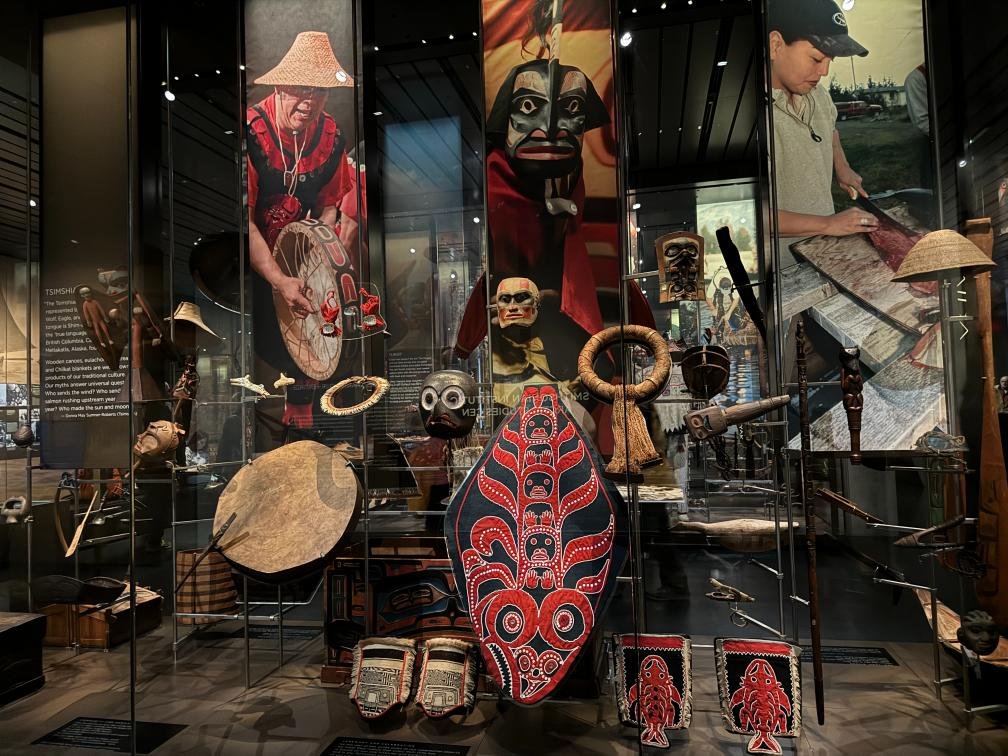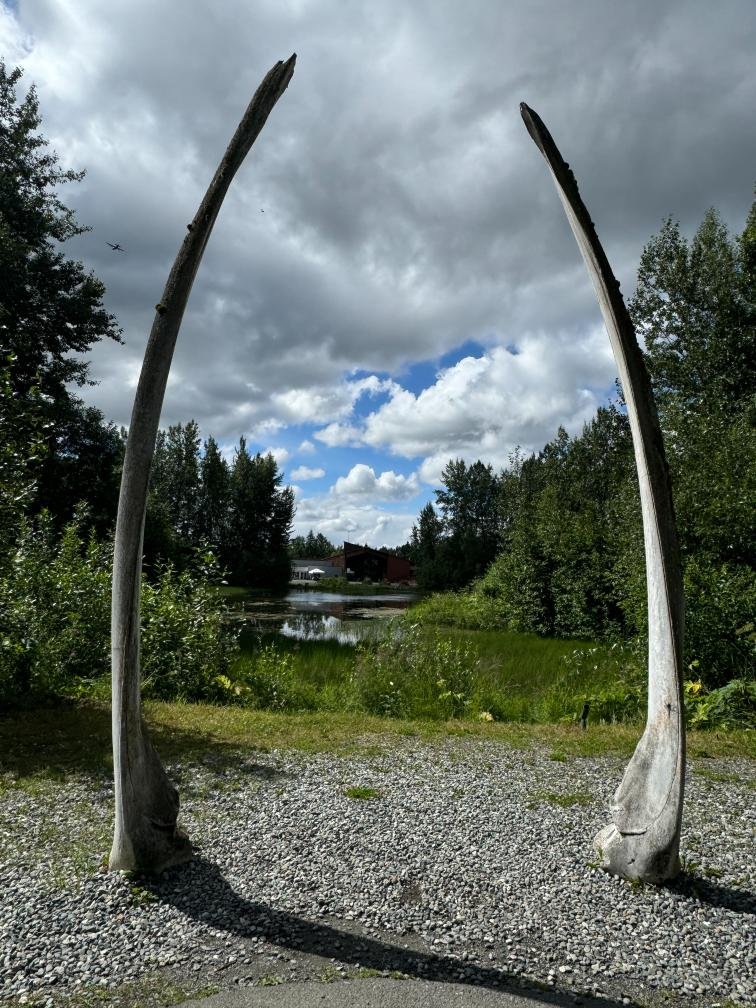
Alaska history and Native cultures come alive at these Anchorage museums

If you’re a first time visitor to Alaska, there’s a good chance you’ll spend a day or two in Anchorage. Though not the capital, the city is the most populous in the state and serves as its main economic and cultural hub.
When it comes to learning about Alaska, its diverse landscape, colorful history and Native cultures, check out the top-rated Anchorage Museum and the Alaska Native Heritage Center. The former is a treasure trove of interactive exhibits and immersive installations that tell the story of the Last Frontier and the North, weaving together social, political, cultural, scientific, historic and artistic elements.
The museum boasts a collection of 27,000 objects, including ethnographic pieces from all Alaska Native cultures, state and local historical pieces dating back to the Russian-American period, and artwork depicting Alaska and the region since the 18th century. With four floors to explore in the 170,000 square-foot building, plan to spend a few hours here.

Alaska Exhibition at the Anchorage Museum. Photo by Debbie Stone

2017 grand opening weekend – new wing reception and preview photos. Sept. 2017 – new wing “Art of the North” and “Alaska” exhibition preview and reception photos Credit: Oscar Avellaneda-Cruz 2017 grand opening weekend – new wing reception and preview photos. Sept. 2017 – new wing “Art of the North” and “Alaska” exhibition preview and reception photos Credit: Oscar Avellaneda-Cruz

Exhibit in the Hall of Cultures at the Alaska Native Heritage Center. Photo by Debbie Stone
Head to the “Alaska Exhibition” to explore the dozen or so thematically-organized exhibits, from “Alaska is Resource” and “Alaska is Wilderness” to “Alaska is Adaptation.” The focus is on presenting the many faces of Alaska and reflecting significant aspects of life in the state, current and past. Told through multiple voices and perspectives, the exhibits offer insight into the identity of Alaska and its people. On view are more than 400 artifacts from the museum’s collections, each presenting a story of the experiences of Alaskans. Multimedia content shines here, too, with several dozen video productions to engage visitors with the material in an approachable way.
In the “Alaska is Wilderness” zone, for example, you’ll explore the myths of the great outdoors and hear real-life stories of people that have escaped into the Alaskan wild. A digital station called “the Viewfinder” allows you to flip through photos and archival images. If you’ve ever romanticized the Last Frontier, some of the stories and photos might change your view, as life isn’t easy in this place.

Cultural interpreter at the Alaska Native Heritage Center. Photo by Debbie Stone

Exhibit at the Smithonian Arctic Studies Center at the Anchorage Museum. Photo by Debbie Stone

Alaska Native Heritage Center. Photo by Debbie Stone

Baked Alaska by Justin Brice Guariglia at the Anchorage Museum. Photo by Debbie Stone

Dwelling at the Village Sites at the Alaska Native Heritage Center. Photo by Debbie Stone
The “Smithsonian Arctic Studies Center” features an extraordinary collection regarding the indigenous people of Alaska with masterworks of Alaska Native art and design from the collections of the Smithsonian’s National Museum of Natural History and the National Museum of the American Indian. Alaska’s Native entities are represented with various items particular to their individual cultures. The clothing and adornment pieces showcase the many parts of an animal, such as the skin/hide, teeth and even gut used to make hats, dresses, coats, footwear, etc., for maximum warmth in the harsh climate.
Another permanent exhibit, “Art of the North,” includes paintings, sculpture, photography, video and other media depicting both land and people through historical and modern day lenses. You’ll see everything from 19th and 20th century lush landscapes to works by contemporary artists, who view “the North as a place in transition, at risk and altered by humankind, with emphasis on indigenous perspectives of land, language and landscape.”
More art is on display in “Arctic Sculpture: Ivory Carvings from the Anchorage Museum Collection.” This exhibit portrays the connection between the walrus and Alaska Native people, who have carved and sculpted walrus ivory for ages. Out of 4,000 ivory items in the museum’s collections, about 75 of them are on display. You’ll find examples of ivory forms made for entertainment, practical purposes and art, with some pieces 120 years old. The intricate scrimshaw work and skillfully carved figurines of birds, mammals and humans are notable.

Dance performance at the Alaska Native Heritage Center. Photo by Debbie Stone

Demonstration of a game at Native Alaska Heritage Center. Photo by Debbie Stone
Artists Alia Shahab’s and Michel Gignac’s “Trailing,” a visitor favorite, is an immersive, interactive sculpture activated by motion. This mesmerizing installation was “inspired by light phenomena found in nature, such as bioluminescent plankton and the aurora borealis.” The pair created the piece from thousands of fiber optic cables, which emit a glowing green light when people move through the installation. When the movement ceases, the cables fade to dark.
In the museum’s Discovery Center, which includes Spark!Lab, hands-on activities take centerstage. Kids and families can delve into the history and process of invention, while using creativity, imagination, problem-solving skills and experimentation.

On the grounds of the Alaska Native Heritage Center. Photo by Debbie Stone

Grey whale skeleton at Alaska Native Heritage Center. Photo by Debbie Stone

Fish skin mittens at the Anchorage Museum. Photo by Debbie Stone
Nearby is a planetarium offering an array of shows about astronomy, the Northern Lights, Earth’s atmosphere, the solar system and more. Tickets to these shows are not included in the general admission.
If it’s historical photos you’re into, the museum’s Atwood Alaska Resource Center has nearly 600,000 pics dating back to the Gold Rush and beyond. And 800 maps!
The Anchorage Museum exceeds expectations on all levels and the depth of exhibits is remarkable, as is the manner in which they balance the many facets of the Last Frontier. This is a great place to start your Alaska trip, as it’s a true primer into the land, history and people.

Trans Alaska Pipeline at the Anchorage Museum. Photo by Debbie Stone

Juneteenth 2021, Courtesy of the Anchorage Museum
Next, head to the Alaska Native Heritage Center, “One of America’s Cultural Treasures.” Celebrating its 25th anniversary this year, the center represents all Alaska Native cultures, peoples and ways of life. It was created by a unanimous vote of the Alaska Federation of Natvies back in 1987, which called for the establishment of a statewide Alaska Native culture center.
There are three main sections: the Hall of Cultures, Gathering Place and Village Sites. In the Hall of Cultures, you can learn about the heritage of Alaska’s major cultural groups: Athabaskan, Eyak, Tlingit, Haida Tsimshian, Unangax (Aleut), Alutiiq, Yup’ik, Cup’ik, Siberian Yupik, and Inupiaq. Rotating exhibits of clothing, artwork and craft created by Alaska Native artists are on display. There are often craft activities for families, too.

Totem at Alaska Native Heritage Center. Photo by Debbie Stone
The Gathering Place is a performance space where visitors have the opportunity to see demonstrations of Alaska Native dancing, Native games, traditional storytelling and more. It’s certainly a highlight of the Center and showcases Native Alaskan youth involvement.
Make your way outside to the Village Sites, which consist of six life-sized, authentic and traditional Alaska Native dwellings, representing major cultural groups. Each house tells the story of its region and people, their relationships to the land, how they adapted and have continued to thrive over the centuries. Artifacts for use in daily life are on display. Some of the dwellings have a culture specialist inside, who can offer additional information.
The sites are centered around picturesque Lake Tiulana and surrounded by lush foliage. Don’t miss the indigenous garden, healing garden and gray whale exhibit. You can do a self-guided or guided tour of the area.
Before you leave, stop by the gift shop, where every purchase goes directly to supporting the Alaska Native artist community and cultural and educational programming at the Center. There’s an array of items from tees and prints to jewelry and high end collectibles.

Welcome to the Anchorage Museum! Photo by Debbie Stone



































